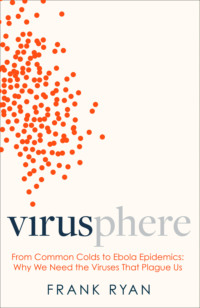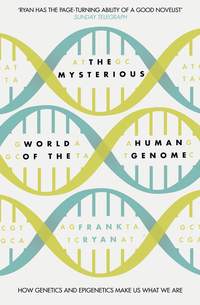
Полная версия
Virolution
Over the ensuing years, I continued to work on the dynamic of emerging plague viruses, and I discovered that aggressive symbiosis worked through a series of very specific steps. It began when the virus invaded a new, or virgin, host. The interaction could result in a variety of different behaviours, depending on whether the virus came from a closely related species, and was thus pre-evolved in its infectious strategies, or whether it came from a more distantly related species, when its infectious strategies would not be so efficiently pre-evolved. The Sin Nombre hantavirus came from a rodent and, though it killed a high percentage of the people it infected, it could not efficiently transmit between people. Several recently notorious viruses Marburg, Ebola, Lassa fever and the South American haemorrhagic fever viruses, such as Machupo and Junin, did exactly the same. Lassa, Machupo and Junin all came from rodents and were not sufficiently transmissible between people. While the hosts of Marburg and Ebola were still uncertain, their failure to transmit efficiently between people suggested a distantly related host. In such cases, the genetic differences been former and new host ensured that the evolutionary dynamic ended there. But where a virus came from a closely related species, such as the rabbit myxomatosis virus, which was symbiotic with the Brazilian wood rabbit, or, as with HTLV and HIV, when it hopped species from monkeys and chimpanzees to the closely related humans, the genetic similarities paved the way for a new evolutionary dynamic. Since the tissue and immune barriers of the original hosts were very similar to those of the new host, these viruses would possess pre-evolved strategies that would work pretty much in the new host as they did in the old. Moreover, all of these viruses had a very important characteristic in common. Once they entered an individual, or species, they never went away, not in terms of the individual, and not in terms of the entire affected population, or even the species. The biological term for such a relationship is “persistence” and the viruses are said to be “persistent viruses”. The very nature of such a long-term, and inevitably intimate, relationship has major implications for the virus-host evolutionary dynamics.
For a virus to enter into such a persistent relationship with a host, it is obvious that the host must be able to survive the long-term presence of the virus. In some cases, this may not necessarily lead to any major manifestations of disease. It is possible, I would even venture likely, that many viruses in nature enter into benign partnerships without the manifestations of what we recognise as a plague – but such interactions, by their very nature, are likely to pass unnoticed. But with myxomatosis, as with HIV, the virgin host, whether Australian rabbit or global human population, cannot live in a benign harmony with the newly arrived virus. A variable proportion, 99.8% of the Australian rabbits, and perhaps as many as 98% of the human species, cannot survive the initial contact with the myxomatosis virus and HIV-1 respectively. Here the first step of aggressive symbiosis kicks in. The invading virus kills all those who cannot live with its presence. I labelled this brutal dynamic “plague culling”. This is what we saw with myxomatosis, and I’m afraid it is what we would likely have seen with AIDS had it arrived among our human, or pre-human, ancestors when they inhabited the geographically contiguous area of the hinterlands of the African rainforest. We can anticipate that plague culling would reduce the new host population to a rudiment, selected by the lethality of the virus, and genetically distinct from the majority of its former population, or species. Although the survivors might be sickly, or have their lives somewhat shortened, the key implication, from the evolutionary perspective, is that they are capable of living with the persisting presence of the virus. The second step of aggressive symbiosis involves long-term co-evolution of virus and host – with the potential of mutualistic partnership.
So went my theory. Some people might disagree with my conclusions. But I could also point out to such sceptics that it was capable of being confronted. If I was right and aggressive symbiosis, evolving to mutualism, was commonplace in nature, it could be confirmed or refuted by looking for the pathognomonic signal of such a partnership: natural selection operating at the level of the partnership.
One of the most useful probes to come from the applications of molecular genetics to evolutionary biology has been our ability to follow the changes in DNA sequences over the vastness of evolutionary time, so we can distinguish genetic sequences that have been conserved by natural selection from those that have not. Viruses, as we have seen, evolve at fantastic speeds. This means that, in the examination of established virus-host partnerships, if we detect highly conserved viral sequences, this would be suggestive of selection working at the level of the partnership. If we could then take this a step further and demonstrate that those same conserved viral sequences were contributing to host survival – or, in symbiotic terms, to survival at holobiontic level – this would provide conclusive evidence for the evolutionary paradigm of virus-host symbiosis.
In fact, when we look for evidence of selection at partnership level in nature, it proves not unduly difficult to find it.
Many of my readers, whether biologists or non-biologists, will be familiar with the cruel life cycle of the parasitic wasps, where approximately 25,000 species of insects have entered into aggressive symbiotic partnerships with approximately 20,000 species of polydnaviruses. The partnership has become so intimate that many of the viruses have entered the germ line of the wasps, to emerge, as fully formed viruses, when the wasp is laying its eggs. Whether the viruses live around the wasp ovaries, or whether they emerge from the wasp genome at the time of egg-laying, they are inevitably injected into the caterpillar prey along with the wasp’s eggs. In normal circumstances the wasp’s eggs would not survive – they would be detected and destroyed by the immune system of the caterpillar. But here viral aggression comes into play, paralysing the immune system of the caterpillar, and then taking over key aspects of its internal chemistry to convert it into a brood chamber for the emerging wasp larvae. The full complexity of the symbiosis has proved to be a source of wonder to biologists, with viruses compelling the caterpillar to produce sugars to feed the larvae, and even going so far as to disrupt the caterpillar’s hormonal system, thereby preventing its natural metamorphosis into a butterfly or moth.
There can be little doubt that here we see selection operating at the level of the partnership, with viral genes and behaviour greatly enhancing the survival potential of the wasp. And when biologists, such as Provost and Whitfield, investigated the wasp-virus partnership, they found that it dated back to a single symbiotic union, approximately 74 million years ago, during the age of the dinosaurs.7
Конец ознакомительного фрагмента.
Текст предоставлен ООО «ЛитРес».
Прочитайте эту книгу целиком, купив полную легальную версию на ЛитРес.
Безопасно оплатить книгу можно банковской картой Visa, MasterCard, Maestro, со счета мобильного телефона, с платежного терминала, в салоне МТС или Связной, через PayPal, WebMoney, Яндекс.Деньги, QIWI Кошелек, бонусными картами или другим удобным Вам способом.






